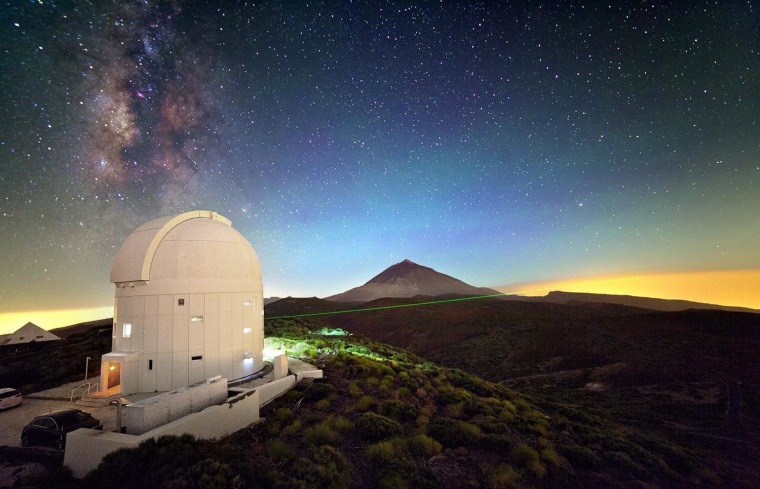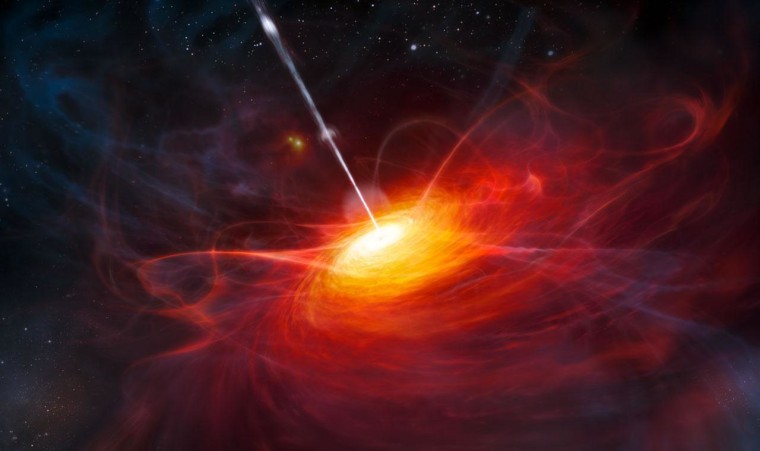An experiment of cosmic proportions, looking at some of the most distant visible corners in the universe, could help close what may be the last major loophole in quantum physics, or shake it to its very foundations.
In the bizarre realm of quantum physics, two or more particles can get linked so they stay in sync instantaneously no matter how far apart they are. Albert Einstein derisively called this seemingly impossible connection "spooky action at a distance." Nowadays, scientists give it the name quantum entanglement. Einstein believed that quantum entanglement could be explained on a deeper level by the more intuitive laws of classical physics.
In the classical picture, two objects in different regions of space could not influence each other faster than the speed of light. Also, every particle would have well-defined properties at every moment in time — classical mechanics-based, "hidden variables" that would dictate the strangely synchronized entangled behavior between the particles.
Fifty years ago, physicist John Bell devised a mathematical formula that predicted what scenarios would occur if the counterintuitive predictions of quantum physics were governed by these classical hidden variables. Experiments on Bell's theorem have supported a purely quantum physics picture, rejecting the existence of hidden variables and showing that particles are linked more strongly than one would expect under the laws of classical physics.
However, researchers have also identified major potential loopholes in Bell's theorem.
The 'free will' loophole
Two have been closed, but a third remains, "one known as 'setting independence' or sometimes colorfully called the 'free will' loophole," said David Kaiser, a theoretical physicist at the Massachusetts Institute of Technology. "It's a really crazy-sounding loophole, but it turns out it's the easiest way to fake an outcome in tests of Bell's theorem."
In this scenario, the two detectors measuring the entangled particles have a shared history, via an event, information or third party they have in common. This could link them and lead to biased results. Therefore, a scientist testing Bell's theorem would not have complete control in choosing what each detector measures.
To solve this loophole, Kaiser and his colleagues have proposed looking for answers from the most remote corners of the known cosmos.
The experiment they propose relies on the fact that the universe has been expanding ever since the Big Bang happened nearly 14 billion years ago. As such, objects can be far enough away from each other to have been out of contact since the beginning of the cosmos, with no way for any signal to have ever reached from one to the other. This makes it possible to test the last loophole in Bell's theorem for a so-called "Cosmic Bell" experiment.
Quantum query by quasar
The experiment would involve a pair of telescopes, aimed at opposite sides of the sky at different quasars — supermassive black holes up to billions of times the mass of the sun, which release extraordinarily large amounts of light as they devour matter.
The experiment would create two entangled particles here on Earth and send one of the two to both telescopes. The particles would be measured by detectors at the telescope, machines that would rely on information from the two unconnected quasars to determine which properties they would measure of the two entangled particles.
"There could be weird activity in the very earliest moments of the Big Bang."
The scientists reason that because each detector's settings are controlled by quasars that have shared no history since the universe was born, it should be impossible for these detectors to be part of a conspiracy to skew their results. If the experiment discovered the measurements of the entangled particles matched each other more than predicted by the laws of classical physics, that should close the "free will" loophole.
The researchers expect this experiment to verify quantum theory's predictions, but if the test finds otherwise, "that would be a win also," Kaiser said. "It could mean that we have to change quantum theory, the fundamental theory governing matter. Or it could mean that there could be weird activity in the very earliest moments of the Big Bang."
Targeting the Canary Islands
Kaiser said the experiment is possible using modern technology.
The distance between each telescope and the source of the entangled particles needs to be on the order of 30 miles (50 kilometers). Scientists have already carried out experiments with entangled particles 90 miles (144 kilometers apart), between the two Canary Islands of La Palma and Tenerife off the northwest coast of Africa.
"It turns out the Canary Islands have some of the largest optical telescopes in the world, so maybe we could do it there," Kaiser said.

High energy physicist Warren Huelsnitz with the MiniBooNE experiment at Fermilab in Batavia, Ill., who did not take part in this research, noted that the experiment would be very challenging. Scientists would have to make sure the light measured by the telescopes really came from the quasars, as opposed to light pollution on Earth or scattered starlight.
"If Bell's inequality is not violated in the 'Cosmic Bell' experiment, then that would be truly amazing, and it would set quantum mechanics, and perhaps all of physics, on its head," Huelsnitz said. However, Huelsnitz predicts that the results will likely be consistent with previous tests of Bell's theorem.
Even closing this loophole "will not entirely rule out hidden-variables theories," cautioned theoretical physicist Sabine Hossenfelder at the Nordic Institute for Theoretical Physics in Stockholm, Sweden, who did not participate in this study. For instance, there are so-called superdeterministic hidden variables that Bell's theorem cannot be used to test. She is now investigating whether experiments could show whether those hidden variables exist or not as well.
Kaiser and his colleagues Jason Gallicchio and Andrew Friedman will detail their findings in the journal Physical Review Letters.
This report, "Cosmic Experiment Aims to Close Loophole in Quantum Theory," was first published by Inside Science News Service. Copyright 2014 American Institute of Physics. Reprinted with permission.
